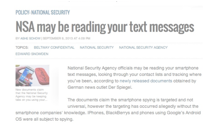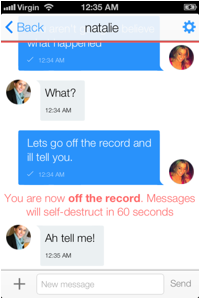Ansa
Finally, a messaging service you can trust
It hurts me to think some of the best things about this country are shrinking. The middle class. Factory jobs. Affordable nice urban neighborhoods. And politicians who give a damn.
Ranking right up there with the rest is privacy.
Internet users, especially those who send messages, pictures and videos to others online, are shockingly exposed to government and non-government entities wanting to peek into their private online lives.
I’m not the only one who feels this way.
In early December 2013, Tech giants Facebook, Apple, Google, Microsoft and four others wrote to President Obama calling for an overhaul of surveillance laws.
It’s needed, they say, to restore public trust in the Internet. They want to limit the power of government to “compel” Internet providers to hand over data. “The balance in many countries has tipped too far in favor of the state and away from the rights of the individual,” adding that “this summer’s revelations highlighted the urgent need to reform government surveillance practices worldwide.”
While not mentioned by name, you can see the NSA’s handiwork all over this petition. Its heavy-handed surveillance practices drew public condemnation all over the world…

But when Microsoft says, “People won’t use technology they don’t trust,” I don’t think it gets it.
People won’t stop using the Internet. It’s too ingrained into their daily lives. Instead, they’ll search for new technology they can trust.
Until the government does something about protecting the privacy rights of the individual, it’s up to the private sector to take up the gauntlet.
This is where companies like Snapchat and Ansa come into play.
Snapchat was created to let users send photos that disappear after up to 10 seconds. Facebook reportedly offered to buy it for $3.5 billion. China’s Tencent Holdings made a better offer – $4 billion. Why? People want more control… and Snapchat is just the beginning of what consumers expect. Today, we’d like to introduce you to the next big company in the privacy space.
Ansa is an exciting new company on the scene. I believe its technology… versatility… and ability to make things disappear from the web is clearly superior to what Snapchat offers.
I also believe, if Ansa catches on, it could exceed Snapchat’s upside. Ansa’s sharp CEO, Natalie Bryla, doesn’t even consider Snapchat a competitor because it doesn’t really do what Ansa does.
Ansa is a messaging application. It allows people to send disappearing texts to friends. With options to chat off-the-record (so no trace of a conversation is left behind)… send self-destructing photos and videos… and take back messages you change your mind about, Ansa is no pale version of Snapchat.
“Snapchat is a simple photo sharing application. Ansa is a full-featured messaging application designed for privacy and control,” Bryla says.
Unlike Snapchat, Ansa truly ensures people have the privacy and control they expect.
What convinced me of Ansa’s vast potential was when I realized that it has singlehandedly destroyed a long-standing myth about the Internet.
If you know anything about Las Vegas, then you know exactly what I mean.
Taking It Back
You know what they say about Las Vegas, right? Whatever happens in Las Vegas stays in Las Vegas.
Well, the online equivalent to Las Vegas is the Internet.
Whatever happens on the Internet stays on the Internet. What I mean is…
The things we said on the Internet stayed on the Internet. What pictures were posted could never be unposted. Whatever videos were shown could never be unshown.
Every one of our mistakes… embarrassments… errors of commission and emission… was forever captured.
So, how does Ansa secure your conversations and ensure they really do go away when you want them to?
It’s pretty simple. The company uses military-grade encryption, and stores the keys to unlock this encryption on the phones instead of the server.
“Even the NSA can’t access the files clients choose to delete,” says Bryla. “They’re gone from our servers. And, without an encryption key, they’re literally impossible to recover.”
Wait a minute. This is the super high-tech NSA we’re talking about. Google, iChat, Facebook, LinkedIn, all these big companies with platforms that have been fortified against unwanted intrusions, are all susceptible to NSA snooping.
Could it really be true that Ansa’s app is beyond the reach of the NSA?
When I asked Bryla to think hard and give me a scenario that could breach Ansa’s private and secure messaging and media sharing technology, she couldn’t think of any.
“Let’s Go Off the Record”
I give Ansa’s technology a top grade because, unlike Snapchat, it does what it claims.
It’s also obvious that Ansa’s team has put a lot of thought into the product. It gives you a range of options that make sure users are in control.
The option you’d probably use the most is the “off-the-record” mode.

With this option, messages automatically self-destruct from both people’s phones in 60 seconds, so you can have full conversations without leaving a trace behind.
But what happens if you’re not in off-the-record mode and, five days later (it could also be five years!), you want to delete a message?
No problem. With Ansa you can take back the messages you change your mind about. You simply use the “sync deletion” feature. When you erase a message from your phone, it’s automatically removed from the recipient’s phone too.
Well-thought-out, no?
When sending photos, videos and drawings, you can tell your phone to destroy them almost instantaneously (within one to 60 seconds). You can also take or upload photos or videos and edit and make comments on or beside them.

But Can It Make Money?
In other words, can it do what Snapchat hasn’t been able to do yet? (May I remind you that Snapchat’s valuation is in the $3.5 billion to $4 billion range.)
Like everything else, Ansa has thought about this and has come up with a clever angle to monetize its user base. Ansa plans to create a platform for “ephemeral ads.” These ads would offer flash deals that only last for seconds.

I like the idea for its simplicity. And the “ephemeral” nature of the ads creates a sense of urgency, a proven sales technique as old as the hills. Yes, it’s completely unproven. And it’s possible that Ansa will be bought out before it has a chance to execute its revenue strategy.
But it’s encouraging that the market for Ansa is quite substantial. We know this from Snapchat’s experience. It processes about 25 images every second. The size of its user base is unknown. But what we do know is that when Instagram was processing around 25 photos a second, it had 10 million users.
Ansa is just beginning to seriously market its app. It already has 30,000 users, a drop in the bucket. It has begun marketing to 35 campuses across the U.S. and is encountering an enthusiastic response among students who sign up for Ansa.
In a short period, Ansa signed up 10% of Berkeley’s 26,000-student campus.
Ansa is available on iOS and Android. You can get it at the App Store and Google Play. (Snapchat is still developing its app for Android.)
Add It All Up…
And you get a company that is setting itself up quite nicely to take advantage of growing privacy concerns. The brains behind Ansa are Natalie Bryla, who previously founded and sold BestFriendBox, a company that sold pet products online, and her co-founder Evgeniy Altynpara, a security expert with experience building messaging apps.
Natalie and I have had several conversations. She strikes me as a very intelligent woman with outstanding entrepreneurial instincts. She launched the company at the TechCrunch Disrupt September 2013 competition, one of the tougher startup venues.

I’ve been saying in my blogs recently how important it is to follow a lead investor. Ansa is more than halfway through its fund raise of $750,000. Among its investors are Link Capital and David Morin, the Founder of Path and a champion of privacy.
This Is What You Should Do…
The terms of your deal: Ansa is seeking loans that can be converted into equity in the next round of funding. The loan gives you a 2% interest rate, and the deal is “capped” at $5 million.
Let me explain to you how this works because it’s important you understand this…
During the next round, if the company sets its valuation at $5 million and shares are $10 each, and you have a $5,000 debt note, that $5,000 will buy you 500 shares. If the company is valued at $10,000, that’s double your capped valuation, so the amount of shares you receive also doubles, from 500 to 1,000.
In either case, your debt turns into equity at the next fundraising round or at the next liquidity event, like a buyout, for example – whichever comes first.
I think that $5 million is a reasonable valuation for a pre-revenue company with a proven product but a very small user base. If Ansa gets decent traction, its valuation will far exceed the $5 million. Case in point is Snapchat.
If you’re interested, please contact Ansa by emailing its Founder and CEO, Natalie Bryla, at natalie@ansa.com. Either Natalie or one of her capable cohorts will email you back, setting up a time to talk on the phone.
To look up Ansa for yourself, here are two sites: Ansa’s website http://www.ansa.com/ and its listing on rockthepost.com.
Important note to subscribers: Investing in startups is inherently risky. We recommend setting aside a small portion of your portfolio for such private investments. Then spread it out across 10-20 companies over the course of a year. This strategy minimizes risk. We also recommend contacting a professional advisor if you have questions, as we cannot provide personalized investment advice.